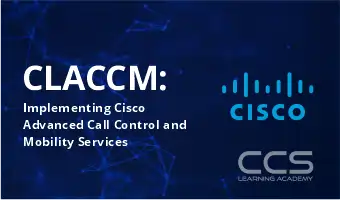CLACCM: Implementing Cisco Advanced Call Control and Mobility Services
* Looking for a flexible schedule (after hours or weekends)? Please call 858-208-4141 or email us: sales@ccslearningacademy.com.
Student financing options are available.
Transitioning military and Veterans, please contact us to sign up for a free consultation on training and hiring options.
Looking for group training? Contact Us
Course schedule:About This Course
Course Description:
Implementing Cisco Advanced Call Control and Mobility Services (CLACCM) is a 5-day course which covers advanced call control and mobility services. Students will learn how to use Cisco® Unified Communications Manager features to consolidate your communications infrastructure into a scalable, portable, and secure collaboration solution. Through a combination of lessons and hands-on experiences, you will also learn about a wealth of other features such as Globalized Call Routing, Global Dial Plan Replication, Cisco Unified Mobility, Cisco Extension Mobility, Device Mobility, Session Initiation Protocol Uniform Resource Identifier (SIP/ URI) call routing, Call Admission Control, Cisco Unified Communications Manager Express and Survivable Remote Site Telephony (SRST) gateway technologies, Cisco Unified Board Element Call deployments, signaling and media protocols, call coverage, and time of day routing.
This course is a part of CCNP Collaboration.
Learning Objectives
Inclusions
- Certified Instructor-led training
- Official Training Seminar Student Handbook
- Collaboration with classmates (not currently available for self-paced course)
- Real-world learning activities and scenarios
- Exam scheduling support*
- Enjoy job placement assistance for the first 12 months after course completion.
- This course is eligible for CCS Learning Academy’s Learn and Earn Program: get a tuition fee refund of up to 50% if you are placed in a job through CCS Global Tech’s Placement Division*
- Government and Private pricing available.*
- *For more details call: 858-208-4141 or email: training@ccslearningacademy.com; sales@ccslearningacademy.com
Pre-requisites
- Internet web browser usability knowledge and general computer usage
- Basic understanding of networking technologies
- Basic understanding of voice and video
- Describe the different codecs and how they are used to transform analogue voice into digital streams
- Knowledge of Cisco Internetworking Operation System (Cisco IOS XE) command line
- Describe the Cisco Collaboration solutions architecture
- Define collaboration and describe the main purpose of key devices in a Cisco collaboration on-premises deployment model
- Configure and modify required parameters in Cisco Unified CM including service activation, enterprise parameters, CM groups, time settings, and device pool
- Deploy and troubleshoot IP phones via manual configuration within Cisco Unified CM
- Describe and configure endpoints and commonly required features
- Compare the IP Phone signaling protocols of Session Initiation Protocol (SIP), H.323, Media Gateway Control Protocol (MGCP), and Skinny Call Control Protocol (SCCP)
- Analyze traffic patterns and quality issues in converged IP networks supporting voice, video, and data traffic
- Define Quality of Service (QoS) and its models
- Describe the call setup and teardown process for a SIP device including codec negotiation using Session Description Protocol (SDP) and media channel setup
- Manage Cisco Unified CM user accounts (local and via Lightweight Directory Access Protocol [LDAP])
- Describe a dial plan and explain call routing in Cisco Unified Communications Manager
- Configure dial plan elements within a single site Cisco Unified CM deployment including Route Groups, Local Route Group, Route Lists, Route Patterns, Translation Patterns, Transformations, SIP Trunks, and SIP Route Patterns
- Implement basic globalized call routing within a Cisco Unified Communications Manager cluster
- Configure calling privileges in Cisco Unified Communications Manager
- Implement toll fraud prevention
- Implement common endpoint features including call park, softkeys, shared lines, and pickup groups
- Implement Public Switched Telephone Network (PSTN) access using Media Gateway Control Protocol (MGCP) gateways
- Implement a Cisco gateway for PSTN access
- Deploy a simple SIP dial plan on a Cisco Interrupt Service Routine (ISR) gateway to enable access to the PSTN network
- Implement and troubleshoot media resources in Cisco Unified Communications Manager
- Manage Cisco Unified CM access to media resources available within Cisco Unified CM and Cisco ISR gateways
- Describe tools for reporting and maintenance including Unified Reports, Real Time Monitoring Tool (RTMT), Distributed Resource Scheduler (DRS), and Call Detail Records (CDRs) within Cisco Unified CM
Target Audience
- Network administrator
- Network architect
- Network designer
- Network engineer
- Network manager







